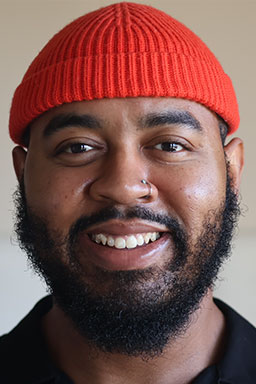Malik Stevenson
Latest News

English Professor Challenges How We Think About Language Through the Lens of Race
*By Larry R. Hygh, Jr., Ed.D.
“My greatest opportunity would be contributing to how we think about language,” says Malik Stevenson, Assistant Professor in English Department at California State University Dominguez Hills (CSUDH). “This is my first more traditional position. I spent five years as an adjunct at American University and Howard Community College.”
Stevenson teaches classes that focus on an introduction to language and linguistic analysis.
As part of his research, he wants to challenge the notions of how people conflate race and language. Stevenson, a fluent Spanish speaker, talks about seeing him as a Black person, and assuming he only speaks English. “We need to challenge the images and ideas of what a Spanish speaker should look like.” He added, “I want to continue to publish research that centers the type of students here at DH.”
Stevenson worked as a K-12 Spanish, and English as a Second Language (ESL) teacher, prior to academia. His research explores intersections between bilingual education and gentrification, the emotional labor of English language teaching for minoritized English language teachers, and the reproduction of raciolinguisitc ideologies. He is passionate about advocacy for education policies that are shaped by the voices of and lived experiences of Black and Brown communities. His teaching interests primarily lie in critical applied linguistics as a means of challenging dominant perspectives about language education, and raciolinguistics to understand how the co-naturalization of race and language impact ideas about language teaching and learning.
Stevenson says a lot of Black women scholars have influenced his work. “There is a lot of overlap between me and them,” he says. “They dared to challenge some of the norms that you have to experience. As a Black person in a dominant white culture, there is nothing normative about that experience.”
Stevenson wants to influence education policy and how we think about educating students. “A lot of students are interested in becoming teachers, and teachers of color are not as common,” he says. “There aren’t as many Black men who take this career path. There are not as many Black men in education.”
Stevenson earned a Ph.D. in Linguistics from Georgetown University, a Master of Arts in Teaching English to Speakers of Other Languages (TESOL) from Notre Dame of Maryland University, and a Bachelor of Arts in Spanish at Xavier University of Louisiana.
Stevenson is a native of Baltimore, Maryland. He is a member of the American Association for Applied Linguistics, the American Educational Research Association, and California Teaching English to Speakers of Other Languages (CATESOL).
What’s the best part of being at CSUDH?
“The students. I’m teaching a lot of content that is heavy on racial justice and centering students of color. It’s great to teach this to mostly students of color…how my research can be useful to them professionally and personally. Many of them are appreciative of this experience…and being able to speak about their own personal experience.”
What advice do you have for students?
“Don’t be scared to make your learning experience as personal as possible. In courses that I’m teaching a lot of students are eager and excited to share about themselves personally…I want to challenge them to make their learning experience as personal as possible.”
What do you like doing outside of being a professor/hobbies
“I’m a big eater. I like to try different bakeries, eating as many pastries as I can from many different places.
He also enjoys reality television to mentally decompress.
What is your favorite quote?
“The heart of justice is truth telling, seeing ourselves and the world the way it is rather than the way we want it to be. More than ever before we, as a society, need to renew a commitment to truth telling.” (Bell Hooks, Author)
Stevenson says this quote drives his teaching and research.
*Hygh is an Assistant Professor in the Communications Department teaching in the Advertising and Public Relations degree program. Prior to academia he spent 20 plus years as chief communications officer in The United Methodist Church. Visit him on the web at www.LarryHygh.com.